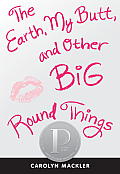"I know what it's like to hate your body so much that you want to hurt it."
 |
| powells.com |
Citation
Mackler, C. (2003). The earth, my butt, and other big round things. Cambridge, Mass: Candlewick Press.
Summary
Virginia Shreves is fifteen, overweight and self-conscious. She also might be the only person in Manhattan--or maybe in the world--who hasn't French-kissed. Her best friend, Shannon, has moved across the country, and her parents don't seem to notice her in between weekend golf trips. Froggy Welsh the Fourth--yes, that's his real name--has provided some physical distractions, but Viriginia still doesn't want him actually seeing her body. Between her classmates, her mother, and herself, she is surrounded by pressure to slim down. And then her older brother, Byron, comes home from Columbia in the middle of the semester. As she deals with her brother's fall from grace, she begins to feel more empowered about her life and her body.
My Impressions
I was initially a little concerned about Virginia's priorities at the beginning of the book, as she seemed somewhat shallow. However, she quickly won me over with her smart, candid voice. She feels very much like a regular teenager, and I quickly related my own teenage insecurities with hers, even if they weren't the same. Her issues are real, relevant, and necessary to confront. Body image, fitting in, family dynamics, boys, friends, and boyfriends are all dealt with in this book, leaving the reader satisfied and, possibly, with a stronger sense of self-confidence.
Reviews
School Library Journal
"Gr 7-10-- Overweight 15-year-old Virginia Shreves is the
misfit in what she perceives as her perfect, thin, good-looking, exceptional
family in this novel by Carolyn Mackler (Candlewick, 2003). Her usually absent
father and adolescent psychologist mother are so stifling that Virginia's older
sister joins the Peace Corp to escape. Big brother Byron is universally adored
by all, particularly Virginia, until halfway through the novel when he is
suspended from college for date rape. Virginia slowly comes to realize that
Byron is the cause of many of her insecurities, and she is the only one in the
family to acknowledge and do something about the fact that he did commit this
terrible crime. The absence of Virginia's best friend, romantic entanglement
with Froggy Welsh, and the many casual cruelties perpetrated on her by the
in-crowd cause Virginia stress and create a serious lack of self- esteem.
However, once she realizes her perfect family isn't quite as flawless as she
thought, Virginia is empowered to stand up to her awful but well-intentioned
mother, reestablish contact with Froggy, and even do the ultimate in teen
defiance-get a body piercing. Johanna Parker is a superb narrator for this
first person novel. She successfully portrays the angry mother, clueless
father, whiny and irresponsible brother, vapid in-girls and, best of all, the
appealing main character. Pacing is excellent and Parker perfectly conveys the
nuances of teen insecurity in all its painful glory. While the author tries to
deal with too many issues and ends up giving many of them short shrift, teens
will certainly care and root for the marvelous Virginia Shreves."
Gray, B.A. & Mandell, P.L. (2004). [Review of the book The earth, my butt, and other round things by C. Mackler]. School Library Journal, 50(12), 76-78. Retrieved from http://www.schoollibraryjournal.com.
Publishers Weekly
""Chubby" New York City teenager Virginia Shreves
is having a hard time: not only is her best friend, Shannon, spending the
school year out west, but Virginia's being pressured about her weight by her
family-especially her formerly fat mother, a prominent adolescent psychologist.
Lonely and insecure, Virginia has even started to hurt herself. When the
brother she worships is suspended from college for date rape, the news shocks
Virginia into realizing that her "stellar" family isn't as perfect as
her mother says it is, and that she doesn't have to conform to her mother's
expectations. Mackler (Love and Other Four-Letter Words) occasionally uses a
heavy hand when it comes to making her points ("Recently, I've been
finding it harder to pretend that everything is A-OK"), and some of the
plot elements, such as the overweight teacher who looks out for Virginia, or
Virginia's discovery that a popular girl has an eating disorder, seem scripted.
The date rape story line, on the other hand, is gutsy; her brother wasn't just
accused of date rape, he actually committed the crime. Ultimately, readers will
find it easy to relate to Virginia; she loves junk food, gets nervous about
finding someone to sit with in the cafeteria and can't believe that Froggy, the
boy she has secretly made out with after school, could be interested in her,
not just using her. The e-mails she exchanges with Shalmon, and the lists she
makes (e.g., "The Fat Girl Code of Conduct") add both realism and
insight to her character. The heroine's transformation into someone who finds
her own style and speaks her own mind is believable-and worthy of applause.
Ages 14-up."
Roback, D., Brown, J.M., Bean, J. & Zaleski, J. (2003). [Review of the book The earth, my butt, and other big round things by C. Mackler]. Publishers Weekly, 250(29), 197.
Suggested Library Uses
- This book would be an excellent inclusion on any teens' book club list. It makes an encouraging story full of discussion points that would hit home with almost any teenage girl.
- Have the teen group start their own webzine where they can share their own thoughts through articles, editorials, comics, etc.
Find it @ Your Library - Albany County Public Library
I FICTION M218E (young adult fiction)
Notes
YALSA Teens' Top 10, ALA, 2004
Michael L. Printz Honor Book, 2004


